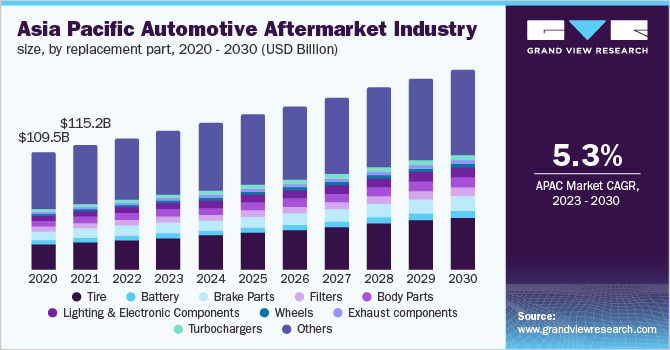What is the Global Automotive Aftermarket Trends 2023
There are several notable trends in the automotive industry that have implications for the aftermarket stakeholders. Firstly, cars are aging, and this is being met with a relatively cool response from aftermarket players. Due to the lack of new car supply, economic concerns, and limited availability of new vehicles, people are holding onto their cars for longer periods. As a result, the scrappage rates for cars are decreasing, leading to a continuous rise in the number of vehicles in operation (VIO). Executives we interviewed at industry events expressed little concern about this trend, as its effects will not be felt for another five or six years. However, the feedback from stakeholders in the aftersales segment, who primarily rely on 1-4-year-old vehicles, was quite the opposite.

The aging fleet, with cars being retained for longer, has caused the average age of vehicles to rise from just over 11 years in 2012 to 12.2 years in 2022. The most significant growth in the vehicle fleet is observed among the 6-13-year-old vehicles, which were already expected to increase in volume even before the current economic climate. This segment of vehicles also tends to travel the most miles annually, making it an attractive target for the aftermarket. These well-traveled vehicles, often owned by their second or third owners, are likely to be prime customers for aftermarket services.
The second trend to note is the return of mileage but with some changes. Annual miles traveled by vehicles have returned to pre-pandemic levels and even exceeded them. However, the composition of these miles traveled has shifted since the pandemic. Analysis of congestion data has shown that rush hours have not fully returned to pre-pandemic levels in all areas, while congestion throughout the day has slightly increased as drivers spread their trips across different times.
The overall effect of these changes in vehicle miles traveled is expected to contribute around 1 percentage point to the total vehicle miles traveled (VMT) in 2022, reaching 3.5 trillion miles for passenger cars and light trucks. This falls within the typical year-on-year VMT change observed before the pandemic. However, the regional variations are expected to be significant, with some areas experiencing a decline in VMT while others see an increase. Similarly, the demand for aftermarket maintenance and repair services based on miles traveled is also expected to vary across regions.
The third trend is the increasing digitization of workshops as vehicle connectivity rises. By 2024, it is estimated that one-third of vehicles in operation (VIO) will be connected, and 5G connectivity will dominate new vehicle services by 2027. By the end of the decade, over one-third of the VIO is expected to be connected, with 95% capable of receiving manufacturer-driven software updates via over-the-air (OTA) updates.
From discussions with diagnostic providers at industry events like Automechanika, it was anticipated that OTA updates would lead to a reduction in warranty visits and could potentially reduce revenue opportunities for original equipment manufacturers (OEMs). Many providers have focused on developing relationships with OEMs and securing access to their secure gateways to enable the aftermarket’s ability to complete all repairs. This has allowed providers to offer connectivity services through subscription or pay-per-repair models, along with technical repair solutions and guidance.
The fourth trend worth mentioning is the increasing adoption of automatic driver-assist systems in vehicles. For instance, in 2022, over 60% of new models were equipped with adaptive cruise control, compared to just 15% five years ago. As a proportion of the vehicle fleet, the presence of vehicles with adaptive cruise control has risen from 0% in 2015 to 12% in 2022.
For the body repair industry, the growing penetration of automatic driver-assist systems technology in the vehicle fleet presents opportunities related to collision rates and the increased demand for cosmetic and smart repair services. Automatic driver-assist systems are susceptible to the effects of poor road conditions and wheel impacts, making calibration and safety checks essential. Additionally, wheel alignment must be checked and adjusted to ensure the proper functioning and safety of automatic driver-assist systems. These services provide significant revenue and upsell opportunities for the aftermarket.
Lastly, the transition to electrification is a prominent trend in the automotive industry. Currently, there are 1.4 million electric vehicles (EVs) in the US, and this number is expected to reach close to 17 million by 2030, with a significant increase in the number of EV models available. However, even with this growth, EVs are projected to account for less than 15% of the overall vehicle fleet by 2030. While more states in the US and Europe are proposing regulations to promote zero- or low-emission vehicles, consumer acceptance of EVs has shown some hesitation due to concerns about technology, pricing, charging infrastructure, and battery technology. Developing and implementing an EV strategy will require pragmatism and careful preparation to ensure a successful transition.
In 2022, light trucks dominated the electric segment among new vehicle registrations, representing 60% of all EVs registered.
Despite the challenges ahead, the future of the aftermarket still holds opportunities in servicing an aging vehicle fleet with increased repair needs. The prolonged aging of cars is expected to continue due to economic factors affecting new car sales, along with ongoing constraints on new car supply until at least 2024. While the growth of EVs is promising, the cautious adoption rate suggests that many customers are waiting to gain confidence in EV technology and infrastructure before fully transitioning to electric vehicles.
Describe Your Needs In Detail!
We will carefully evaluate your needs and give professional solutions.


